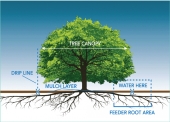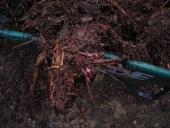




Life that has a meaning wouldn't ask for its meaning. - Theodor W. Adorno








Life that has a meaning wouldn't ask for its meaning. - Theodor W. Adorno




find religion! church
kiva! hyvä! iloinen! pikkumaatila
get stung! beehives
be hospitable! host-a-hive
be antisocial! facespace










Life that has a meaning wouldn't ask for its meaning. - Theodor W. Adorno









Life that has a meaning wouldn't ask for its meaning. - Theodor W. Adorno









Spodosols are acid soils characterized by a subsurface accumulation of humus that is complexed with Al and Fe. These photogenic soils typically form in coarse-textured parent material and have a light-colored E horizon overlying a reddish-brown spodic horizon. The process that forms these horizons is known as podzolization.
Spodosols often occur under coniferous forest in cool, moist climates. Globally, they occupy ~4% of the ice-free land area. In the US, they occupy ~3.5% of the land area.
Many Spodosols support forest. Because they are naturally infertile, Spodosols require additions of lime in order to be productive agriculturally.
Spodosols are divided into 5 suborders: Aquods, Gelods, Cryods, Humods, and Orthods. Click here for more information about these suborders. Click here to view a map of their distribution in the US.
Formed mostly of underlying sandy parent materials, spodosols tend to be strongly leached, with low fertility and limited water storage capacity. Many areas where these soils occur have not been cleared of trees for farming. Large tracts of spodosol border the tundras of North America and Eurasia. Characteristic of these soils are subsurface horizons in which amorphous materials composed of organic matter, aluminum, and iron have accumulated. The heavy application of fertilizers and lime has enabled cultivation of grains, potatoes, berries, and silage corn (maize) on spodosol soils in the cool climate of the north-central United States.
Paul Cereghino- Ecosystem Guild
Maritime Temperate Coniferous Rainforest - Mild Wet Winter, Dry Summer




 )
)Life that has a meaning wouldn't ask for its meaning. - Theodor W. Adorno





Paul Cereghino- Ecosystem Guild
Maritime Temperate Coniferous Rainforest - Mild Wet Winter, Dry Summer





Life that has a meaning wouldn't ask for its meaning. - Theodor W. Adorno





Life that has a meaning wouldn't ask for its meaning. - Theodor W. Adorno

|
When all four tires fall off your canoe, how many tiny ads does it take to build a doghouse?
The new permaculture playing cards kickstarter is now live!
https://www.kickstarter.com/projects/paulwheaton/garden-cards
|







